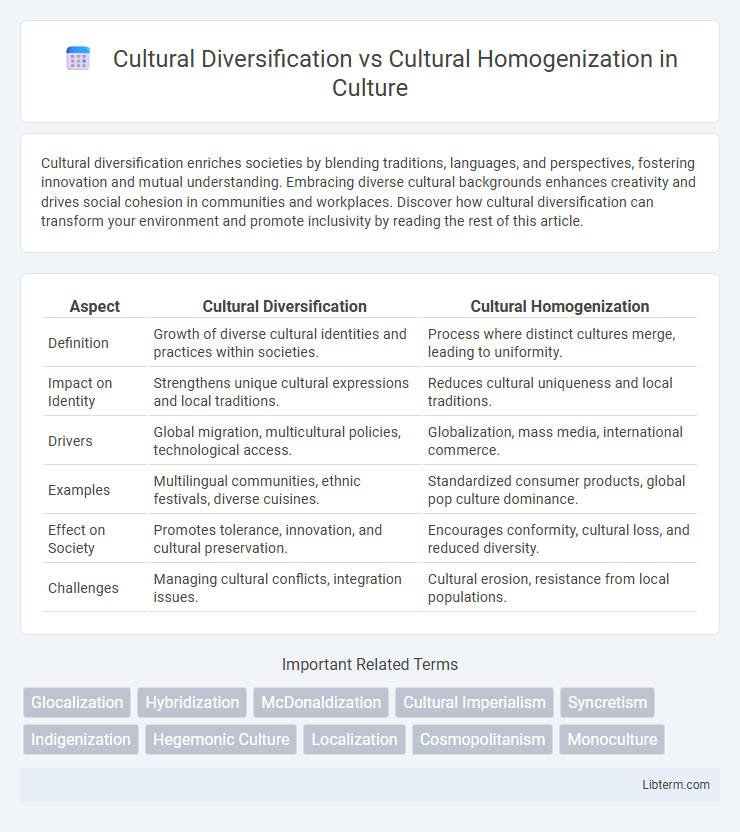Cultural diversification enriches societies by blending traditions, languages, and perspectives, fostering innovation and mutual understanding. Embracing diverse cultural backgrounds enhances creativity and drives social cohesion in communities and workplaces. Discover how cultural diversification can transform your environment and promote inclusivity by reading the rest of this article.
Table of Comparison
| Aspect | Cultural Diversification | Cultural Homogenization |
|---|---|---|
| Definition | Growth of diverse cultural identities and practices within societies. | Process where distinct cultures merge, leading to uniformity. |
| Impact on Identity | Strengthens unique cultural expressions and local traditions. | Reduces cultural uniqueness and local traditions. |
| Drivers | Global migration, multicultural policies, technological access. | Globalization, mass media, international commerce. |
| Examples | Multilingual communities, ethnic festivals, diverse cuisines. | Standardized consumer products, global pop culture dominance. |
| Effect on Society | Promotes tolerance, innovation, and cultural preservation. | Encourages conformity, cultural loss, and reduced diversity. |
| Challenges | Managing cultural conflicts, integration issues. | Cultural erosion, resistance from local populations. |
Defining Cultural Diversification
Cultural diversification refers to the process through which distinct cultural identities, traditions, and expressions emerge and coexist within a society, enriching the social fabric and promoting intercultural dialogue. This phenomenon fosters increased representation of diverse languages, religious practices, artistic forms, and social norms, contributing to cultural resilience and innovation. Emphasizing cultural diversification supports policies aimed at protecting minority cultures and encourages inclusive environments that celebrate multiculturalism.
Understanding Cultural Homogenization
Cultural homogenization refers to the process by which local cultures are transformed or absorbed by dominant outside influences, leading to reduced cultural diversity worldwide. This phenomenon is driven primarily by globalization, advances in communication technology, and the widespread reach of multinational corporations promoting uniform consumer practices and media content. Understanding cultural homogenization requires examining its impact on traditional customs, languages, and identities as global interconnectedness increases.
Historical Roots of Global Cultural Exchange
Historical roots of global cultural exchange trace back to ancient trade routes such as the Silk Road and maritime spice routes, which facilitated the diffusion of goods, ideas, and customs among diverse civilizations. These interactions fostered cultural diversification by blending traditions and innovations across regions, while also laying foundations for cultural homogenization as dominant cultures spread widely through colonization and empire-building. The balance between diversification and homogenization continues to shape global cultural dynamics, reflecting centuries of interconnected human histories.
The Role of Globalization in Shaping Cultures
Globalization accelerates cultural diversification by facilitating the exchange of ideas, languages, and traditions across borders, enriching societies with a mosaic of cultural expressions. Simultaneously, it drives cultural homogenization as dominant global brands, media, and consumer habits spread, leading to a convergence toward shared lifestyles and values. The tension between global cultural integration and local cultural preservation defines contemporary cultural dynamics shaped by globalization.
Benefits of Cultural Diversification
Cultural diversification fosters innovation by merging varied perspectives, leading to enhanced creativity and problem-solving across industries. It preserves unique traditions and languages, enriching global heritage while promoting mutual respect and understanding among communities. Economically, diverse cultures attract tourism and international investments, driving sustainable growth and social cohesion.
Risks and Consequences of Cultural Homogenization
Cultural homogenization poses significant risks including the erosion of unique languages, traditions, and identities, leading to a loss of cultural diversity worldwide. This process often results in diminished creativity and innovation as global cultures become more uniform and less reflective of individual histories. Furthermore, cultural homogenization can exacerbate social tensions and inequalities by marginalizing minority groups and suppressing indigenous knowledge systems.
Technology as a Driver of Cultural Change
Technology accelerates cultural diversification by enabling global access to diverse media, languages, and traditions, fostering unique cultural expressions and hybrid identities. Simultaneously, digital platforms and global networks promote cultural homogenization through widespread adoption of dominant cultural norms and values. The interplay between these forces underscores technology's role in reshaping cultural landscapes by both preserving local distinctiveness and amplifying global cultural convergence.
Case Studies: Cultural Diversification in Action
Cultural diversification is exemplified through case studies such as the multilingual education systems in Canada and the preservation of indigenous languages in New Zealand, showcasing efforts to maintain cultural heritage and promote diversity. The implementation of cultural policies in Singapore fosters a pluralistic society by supporting various ethnic communities and their traditions. These examples highlight how localized strategies can effectively counteract cultural homogenization by valuing distinct identities within globalized contexts.
Case Studies: Cultural Homogenization Impact
Cultural homogenization often leads to the erosion of indigenous traditions, as seen in the widespread adoption of Western fast food and entertainment in countries like Japan and India, which diminishes local culinary and media diversity. The influx of global brands such as McDonald's and Netflix alters consumption patterns, overshadowing native businesses and cultural expressions. This shift not only impacts economic structures but also transforms social identities, reducing the richness of cultural pluralism in affected societies.
Balancing Preservation and Progress in Cultural Dynamics
Cultural diversification fosters the preservation of unique traditions, languages, and practices, enriching global heritage and promoting social inclusivity. Cultural homogenization, driven by globalization and technological advances, accelerates progress but risks eroding local identities and diminishing cultural diversity. Balancing preservation and progress requires strategic policies that protect indigenous cultures while encouraging innovation and cross-cultural exchange to sustain dynamic, resilient societies.
Cultural Diversification Infographic

 libterm.com
libterm.com